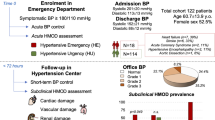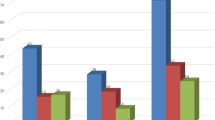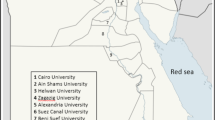Abstract
Hypertensive emergency (HE) is a life-threatening condition that requires immediate blood pressure (BP) reduction. Although it has been on the decline, the incidence of HE has recently increased in a few countries. The aim of the present retrospective study was to evaluate the incidence, aetiology and 1-year mortality of HE in a large medical centre over a 20-year period (1991–2010). The electronic medical records of all patient files who were hospitalized in the Chaim Sheba Medical Center in Israel from 1991 to 2010 with a primary diagnosis (at admission or discharge) of Malignant Hypertension, Hypertensive Emergency or Accelerated Hypertension were retrieved and analysed. The study interval was divided into four periods of 5 years each. Among 306 files reviewed, only 142 patients had a true HE. Average age at presentation was 63.3±16.5 years. Men were younger than women (59±16 vs 68±16 years; P<0.001). At presentation, most patients (80.3%) had been diagnosed with essential hypertension previously and were undertreated. Average maximum mean arterial pressure (MAP) was higher in men (169±22 mm Hg) than in women (161±17 mm Hg; P=0.026). The rate of HE decreased over the course of the study, from 12.7/100 000 admissions during 1991–1995 to 6.2/100 000 admissions (2006–2010). Similarly, 1-year mortality decreased from 16.7 to 3.6%. The rate of HE has decreased and the prognosis has improved over the last two decades. Appropriate BP control of patients with essential hypertension may further decrease the risk of HE.
This is a preview of subscription content, access via your institution
Access options
Subscribe to this journal
Receive 12 digital issues and online access to articles
$119.00 per year
only $9.92 per issue
Buy this article
- Purchase on Springer Link
- Instant access to full article PDF
Prices may be subject to local taxes which are calculated during checkout



Similar content being viewed by others
References
Mancia G, Fagard R, Narkiewicz K, Redon J, Zanchetti A, Bohm M et al. 2013 ESH/ESC Guidelines for the management of arterial hypertension: the Task Force for the management of arterial hypertension of the European Society of Hypertension (ESH) and of the European Society of Cardiology (ESC). J Hypertens 2013; 31 (7): 1281–1357.
Kaplan NM, Victor RG . Hypertensive crises. In: Kaplan’s Clinical Hypertension, Chapter 8, 10th edn. Lippincott Williams & Wilkins, Philadelphia, PA, USA, 2010, 274–285.
Elliott WJ . Clinical features and management of selected hypertensive emergencies. J Clin Hypertens 2006; 8: 275–281.
Shayne PH, Pitts SR . Severely increased blood pressure in the emergency department. Ann Emerg Med 2003; 41 (4): 513–529.
Deshmukh A, Kumar G, Kumar N, Nanchal R, Gobal F, Sakhuia A et al. Effect of Joint National Committee VII report on hospitalizations for hypertensive emergencies in the United States. Am J Cardiol 2011; 108 (9): 1277–1282.
Polgreen LA, Suneja M, Tang F, Carter BL, Polgreen PM . Increasing trend in admissions for malignant hypertension and hypertensive encephalopathy in the United States. Hypertension 2015; 65 (5): 1002–1007.
Garcia GM, Miudo V, Manuel Lopes Cda G, Vassuelela Gomes J . Characterization of patients aged 45 or under admitted with hypertensive emergencies in the Hospital do Prenda. Rev Port Cardiol 2014; 33 (1): 19–25.
Vilela-Martin JF, Vaz-de-Melo RO, Kuniyoshi CH, Abdo AN, Yugar-Toledo JC . Hypertensive crisis: clinical-epidemiological profile. Hypertens Res 2011; 34: 367–371.
González Pacheco H, Morales Victorino N, Núñez Urquiza JP, Altamirano Castillo A, Juárez Herrera U, Arias Mendoza A et al. Patients with hypertensive crises who are admitted to a coronary care unit: clinical characteristics and outcomes. J Clin Hypertens 2013; 15 (3): 210–214.
Weitzman D, Chodik G, Shalev V, Grossman C, Grossman E . Prevalence and factors associated with resistant hypertension in a large health maintenance organization in Israel. Hypertension 2014; 64 (3): 501–507.
Pinna G, Pascale C, Fornengo P, Arras S, Piras C, Panzarasa P et al. Hospital admissions for hypertensive crisis in the Emergency Department: A large multicenter Italian study. PLoS ONE 2014; 9 (4): e93542.
Peacock F, Amin A, Granger CB, Pollack CV Jr, Levy P, Nowak R et al. Stat Investigators. Hypertensive heart failure: patient characteristics, treatment, and outcomes. Am J Emerg Med 2011; 29 (8): 855–862.
Shlomai G, Kopel E, Goldenberg I, Grossman E . Temporal trends in management of hypertension among Israeli adults, 2002-2010: lesson from the Acute Coronary Syndromes Israeli Survey (ACSIS). J Am Soc Hypertens 2014; 8 (2): 94–102.
Koifman E, Tanne D, Molshatski N, Leibowitz A, Grossman E . Trends in antihypertensive treatment—lessons from the National Acute Stroke Israeli (NASIS) registry. Blood Press 2014; 23 (5): 262–269.
Flanigan JS, Vitberg D . Hypertensive emergency and severe hypertension: what to treat, who to treat, and how to treat. Med Clin North Am 2006; 90: 439–451.
Katz JN, Gore JM, Amin A, Anderson FA, Dasta JF, Ferguson JJ et al. Practice patterns, outcomes, and end-organ dysfunction for patients with acute severe hypertension: the studying the treatment of acute hypertension (STAT) Registry. Am Heart J 2009; 158: 599–606.
Acknowledgements
We would like to thank Dr Yasmin Abu-Ghanem for assisting with the statistical analysis.
Author information
Authors and Affiliations
Corresponding author
Ethics declarations
Competing interests
The authors declare no conflict of interest.
Rights and permissions
About this article
Cite this article
Leiba, A., Cohen-Arazi, O., Mendel, L. et al. Incidence, aetiology and mortality secondary to hypertensive emergencies in a large-scale referral centre in Israel (1991–2010). J Hum Hypertens 30, 498–502 (2016). https://doi.org/10.1038/jhh.2015.115
Received:
Revised:
Accepted:
Published:
Issue Date:
DOI: https://doi.org/10.1038/jhh.2015.115



